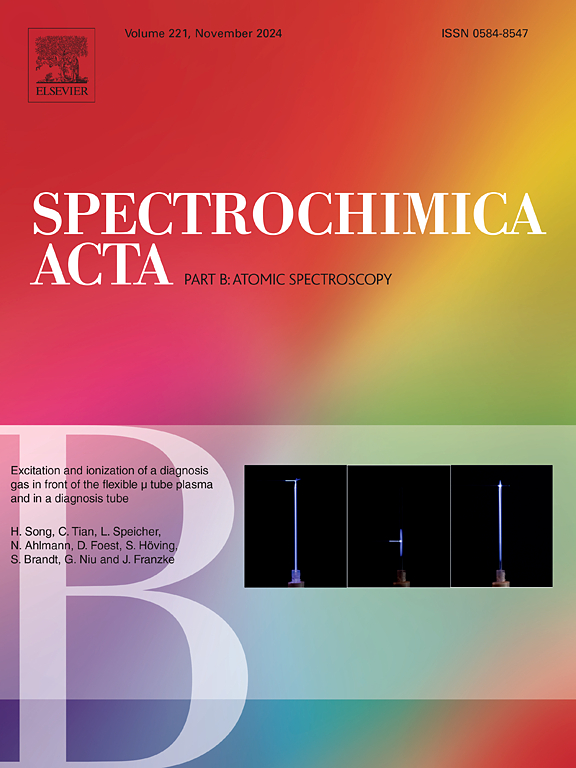与 LIBS 分析氢同位素保留相关的巴尔默阿尔法线的分辨研究
IF 3.2
2区 化学
Q1 SPECTROSCOPY
引用次数: 0
摘要
由于在分辨氢同位素巴尔默α线(Hα、Dα 和 Tα)方面存在实验限制,因此利用激光诱导击穿光谱(LIBS)来检测聚变装置中的氘和氚滞留是一项重大挑战。本研究通过确定最大线宽和相应的等离子体参数,利用瑞利准则来区分 Tα 和 Dα 线。通过在氩气和氦气气氛中对掺重水的石墨/硅胶靶进行 LIBS 分析,对预测的等离子体参数和线剖面形状进行了实验验证。优化激光脉冲能量、气体压力、延迟和栅极时间的目的是根据氘和氢巴尔默α线的强度、宽度和倾角实现完全解析的线。通过微调这些实验参数,研究成功地实现了 Hα 和 Dα 线之间小于 10 % 的倾角,信噪比令人满意,证明了完全解析 Tα 和 Dα 线的可行性。这些发现强调了 LIBS 在增强聚变装置中氘和氚滞留检测方面的潜力。本文章由计算机程序翻译,如有差异,请以英文原文为准。
Resolving studies of Balmer alpha lines relevant to the LIBS analysis of hydrogen isotope retention
Utilizing Laser-Induced Breakdown Spectroscopy (LIBS) for detecting deuterium and tritium retention in fusion devices poses a significant challenge due to the experimental limitations in resolving hydrogen isotope Balmer alpha lines (Hα, Dα, and Tα). This study utilizes the Rayleigh criterion to distinguish Tα and Dα lines by determining the maximum line widths and corresponding plasma parameters. Experimental validation was performed through LIBS analysis of heavy water-doped graphite/silica gel targets in both argon and helium atmospheres to assess the predicted plasma parameters and line profile shapes. The optimization of laser pulse energy, gas pressure, delay, and gate times aimed at achieving fully resolved lines based on the intensity, width, and the dip between deuterium and hydrogen Balmer alpha lines. By fine-tuning these experimental parameters, the study successfully achieved a dip of less than 10 % between the Hα and Dα lines with a satisfactory signal-to-noise ratio, demonstrating the feasibility of fully resolving the Tα and Dα lines. These findings underscore the potential of LIBS in enhancing the detection of deuterium and tritium retention in fusion devices.
求助全文
通过发布文献求助,成功后即可免费获取论文全文。
去求助
来源期刊
CiteScore
6.10
自引率
12.10%
发文量
173
审稿时长
81 days
期刊介绍:
Spectrochimica Acta Part B: Atomic Spectroscopy, is intended for the rapid publication of both original work and reviews in the following fields:
Atomic Emission (AES), Atomic Absorption (AAS) and Atomic Fluorescence (AFS) spectroscopy;
Mass Spectrometry (MS) for inorganic analysis covering Spark Source (SS-MS), Inductively Coupled Plasma (ICP-MS), Glow Discharge (GD-MS), and Secondary Ion Mass Spectrometry (SIMS).
Laser induced atomic spectroscopy for inorganic analysis, including non-linear optical laser spectroscopy, covering Laser Enhanced Ionization (LEI), Laser Induced Fluorescence (LIF), Resonance Ionization Spectroscopy (RIS) and Resonance Ionization Mass Spectrometry (RIMS); Laser Induced Breakdown Spectroscopy (LIBS); Cavity Ringdown Spectroscopy (CRDS), Laser Ablation Inductively Coupled Plasma Atomic Emission Spectroscopy (LA-ICP-AES) and Laser Ablation Inductively Coupled Plasma Mass Spectrometry (LA-ICP-MS).
X-ray spectrometry, X-ray Optics and Microanalysis, including X-ray fluorescence spectrometry (XRF) and related techniques, in particular Total-reflection X-ray Fluorescence Spectrometry (TXRF), and Synchrotron Radiation-excited Total reflection XRF (SR-TXRF).
Manuscripts dealing with (i) fundamentals, (ii) methodology development, (iii)instrumentation, and (iv) applications, can be submitted for publication.

 求助内容:
求助内容: 应助结果提醒方式:
应助结果提醒方式:


